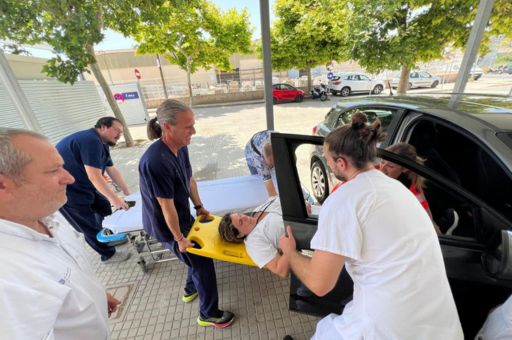The course focuses on assisting non-autonomous patients arriving at the Emergency Department by private vehicle
The team of orderlies at Manacor Hospital has recently participated in a specialised training session organised by SAMU 061, aimed at improving the handling and mobilisation of non-autonomous patients who arrive at the Emergency Department by private car. This training emphasised ergonomics techniques, patient mobilisation, and the correct use of materials for immobilisation and transfer.
This pioneering initiative at the hospital has been very well received and demonstrates the orderlies’ commitment to continuously improving the quality of care. The training has strengthened safety measures for both patients and professionals during the critical moment of arrival at the Emergency Department.
An Essential Role, Increasingly Recognised
Orderlies play a fundamental role in the daily operations of Manacor Hospital. Their duties range from receiving and mobilising patients at the Emergency Department entrance to supporting operating room activities, transferring patients between departments, assisting healthcare staff with mobilisations, and transporting documentation and medication.
The current team consists of 52 professionals distributed across different units, including Pharmacy, Psychiatry, Emergency, and Operating Theatres. For example, the Surgical Block alone has 14 orderlies and a shift supervisor who oversees task organisation and distribution.
TDB keeps you informed. Follow us on: Facebook, Twitter and Instagram
Orderlies at Manacor Hospital Expand Training with SAMU 061 to Improve Emergency Patient Care
Recent years have been key for this group: workforce expansion, greater visibility of their role, and increasing participation in committees and working groups such as BPSO, Humanisation of Emergency Care, ICU, Teaching, Environment, and Patient Safety. In some cases, medical residents have even spent a day shadowing orderlies to understand their work firsthand — an initiative that is expected to be extended to other units and professional categories.
Continuous training is another cornerstone of this team: from containment techniques in Emergency and Psychiatry services to cardiopulmonary resuscitation manoeuvres, safe mobilisations, use of hoists and assistive devices, and humanisation sessions.
The incorporation of key roles, such as the shift supervisor, has improved organisation, reduced response times, and enhanced the onboarding process for new staff. The orderlies’ commitment to quality, safety, and patient-centred care is a clear example of how every part of the healthcare system contributes to delivering excellent service.
